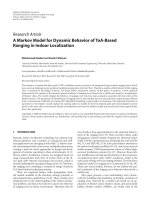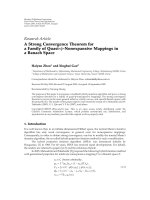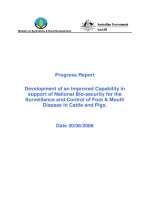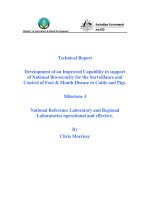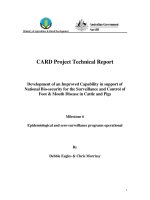Control stategy for marine riser of position moored vessel in open and level ice covered sea
Bạn đang xem bản rút gọn của tài liệu. Xem và tải ngay bản đầy đủ của tài liệu tại đây (6.7 MB, 152 trang )
CONTROL STRATEGY FOR MARINE RISER OF
POSITION-MOORED VESSEL IN OPEN AND LEVEL
ICE-COVERED SEA
NGUYEN HOANG DAT
NATIONAL UNIVERSITY OF SINGAPORE
2011
CONTROL STRATEGY FOR MARINE RISER OF
POSITION-MOORED VESSEL IN OPEN AND LEVEL
ICE-COVERED SEA
NGUYEN HOANG DAT
(B.Eng. (Hons.), HCMUT)
A THESIS SUBMITTED
FOR THE DEGREE OF DOCTOR OF PHILOSOPHY
DEPARTMENT OF CIVIL ENGINEERING
NATIONAL UNIVERSITY OF SINGAPORE
2011
i
ACKNOWLEDGEMENTS
First of all, I would like to express my sincere appreciation to my supervisor,
Professor Quek Ser Tong, at the Department of Civil Engineering, National University
of Singapore (NUS), for his encouraging and providing continuous guidance during
my research. He was always willing to answer my questions, check my results and
suggest new problems.
I am also grateful to Professor Asgeir J. Sørensen, at the Center for Ships and
Ocean Structures at the Norwegian University of Science and Technology (NTNU),
for his support which permitted my experimental studies at NTNU. A special thank to
my co-supervisor, Dr. Nguyen Trong Dong, at Marine Cybernetics (Trondheim,
Norway), for his advices and encouragements to this research. He always shares his
knowledge regarding marine control systems and this helps me a lot in my research. I
also express my appreciation to NTNU laboratory staff, Torgeir Wahl and Knut Arne
Hegstad, for helping with the experimental set-up.
I would like to thank Dr. John Halkyard from John Halkyard & Associates for
answering my questions concerning riser and mooring systems.
Finally, I would like to acknowledge my parents and my wife who have
demonstrated through example the meaning of commitment and understanding. Their
loves are always my strong support during the whole difficult time of my research.
This work has been supported by the NUS Research Scholarship. The
experiments presented in this thesis have been carried out at the Center for Ship and
Ocean Structures (CeSOS), NTNU. The Research Council of Norway is the main
sponsor of CeSOS.
ii
TABLE OF CONTENTS
Acknowledgements i
Table of Contents ii
Summary vi
List of Tables viii
List of Figures ix
List of Symbols xiii
List of Abbreviations xvii
Chapter 1. Introduction 18
1.1 Background and Motivation 18
1.2 Brief Review of Previous Works 20
1.2.1 Modelling of Marine Risers 20
1.2.2 Control of Marine Risers 25
1.2.3 Control of Riser End Angles 26
1.2.4 Station Keeping for Drilling Operations in Ice-covered Sea 27
1.3 Objectives and Scope 30
1.4 Outline of Thesis 31
Chapter 2. Model of Vessel-Mooring-Riser System 33
2.1 Introduction 33
2.2 Kinematics and Coordinate Systems 33
2.3 Model of Riser 36
2.3.1 Governing Equation of Motion 36
2.3.2 Stiffness Model 38
2.3.3 Inertia Model 41
2.3.4 Damping Model 42
2.3.5 Load Model 43
iii
2.3.6 Governing Equation of Motion in FE method 44
2.4 Multi-cable Mooring System 46
2.4.1 Force in a Mooring Line 47
2.4.2 Restoring Force from Spread Mooring System 52
2.4.3 Total Contributions from Mooring System 53
2.5 Model of Vessel Motion 54
2.5.1 Low Frequency Vessel Model 55
2.5.2 Linear Wave-frequency Vessel Model 61
2.6 Concluding Remarks 62
Chapter 3. Control of Riser End Angles by Position Mooring 63
3.1 Introduction 63
3.2 Measurement of Top and Bottom Riser Angles 63
3.3 Structure of Control System 64
3.4 Control Plant Model of Vessel and Riser 65
3.4.1 Control Plant Model of Vessel 65
3.4.2 Control Plant Model of Riser Angles 68
3.5 Plant Control of Vessel-riser-mooring System 69
3.5.1 Nonlinear Passive Observer 69
3.5.2 Control of Mooring Line Tension 71
3.5.3 Mooring Line Allocation 74
3.5.4 Heading Control by Thrusters 78
3.6 Local Optimization: Optimal Set-point Chasing 78
3.6.1 Optimal Vessel Position accounting for Riser Angle Criterion 78
3.6.2 Reference Model 79
3.7 Numerical Simulations 80
3.7.1 Problem Definition 80
3.7.2 Effect of Vessel Offset on REAs 82
3.7.3 Effect of Position Mooring Control 83
3.7.4 Comparison with DP System 86
3.8 Experimental Tests 87
3.8.1 Experimental Set-up 88
3.8.2 Experimental Results 90
iv
3.9 Conclusions 92
Chapter 4. Minimization of Riser Bending Stresses 94
4.1 Introduction 94
4.2 Calculation of Riser Bending Stresses 94
4.3 Control Criterion based on End Angles 95
4.3.1 Problem Statements 95
4.3.2 Simulation Results and Discussions 96
4.4 Control Criterion based on End Bending Stresses 100
4.4.1 Optimal Set-point Chasing 100
4.4.2 Simulation Results and Discussions 101
4.5 Conclusions 104
Chapter 5. Control of Position Mooring Systems in Ice-covered Sea 106
5.1 Introduction 106
5.2 Level Ice Load Model 107
5.2.1 Determination of Contact 111
5.2.2 Crushing and Bending Failure 112
5.3 Vessel-ice Interaction Model 115
5.4 Numerical Example 118
5.5 Simulation Results 121
5.5.1 Effect of Vessel Offset on REAs 121
5.5.2 Effect of Position Mooring Control 122
5.6 Conclusions 128
Chapter 6. Conclusions and Future Works 129
6.1 Summary of Key Points 129
6.2 Conclusions 130
6.3 Recommendations for Further Work 131
References 133
Appendix A. Marine Cybernetics Laboratory (MCLab) and Cybership III Model 142
A.1 Marine Cybernetics Laboratory (MCLab) 142
A.2 Cybership III Model 145
v
Appendix B. Marine Systems Simulator 149
Appendix C. Publications and Submitted Papers 150
C.1 Journal Papers 150
C.2 Conference Papers 150
vi
SUMMARY
Increasing safety and efficiency of drilling operation is a challenging research
topic in offshore engineering especially when the operating location changes. Ensuring
that marine risers remain functional during operations under “normal” environmental
condition is critical. The main objective of the study is to present a control strategy for
maintaining small end angles of marine riser during shallow water drilling operations
by position-moored (PM) systems in open water and level ice-covered sea. Basically,
an active positioning control using mooring line tensioning to reduce the riser end
angles (REAs) in open sea is first formulated and illustrated numerically. Model
experimental tests are then performed to validate the proposed control strategy. In
addition, stresses along the riser due to bending are considered numerically, including
the case where end bending stiffeners are used, which requires the REA control
criterion to be replaced by one with terms related to the stresses at the riser ends. The
proposed REA control strategy using line tensioning with vessel set-point chasing
algorithm is extended for operation in level ice-covered sea.
In the normal drilling and work-over operations, the riser angles at the well-head
and top joint must be kept within an allowable limit (ideally within ±2
o
) to prevent the
drilling string wearing against the ball joints and guarantee continuous drilling
operation. Although this can be achieved by applying sufficient tension at the top of
the riser, this may lead to higher stresses, requiring the use of pipes with higher
strength or dimensions. Alternatively, the vessel may be moved to reduce the mean
offset, and hence the REAs, by tensioning the mooring lines under normal
environmental conditions. This minimizes the need for and/or fuel consumption of
thrusters to control the surge and sway.
In this study, the minimization of vessel offset and REAs of the vessel-mooring-
riser system is achieved by automatically changing the lengths of the mooring lines
based on optimal set-point chasing. To design the control strategy, the mathematical
model of the riser, mooring system and vessel is formulated. The riser is modeled
using beam elements which include the flexural stiffness, since the latter can contribute
significantly in shallow water condition. The cable catenary equation is used to analyze
the mooring line and the effect of mooring is applied on the hull as position-dependent
vii
external forces. The effect of the motions of the hull subjected to the environmental
loads is integrated into the system by imposing externally defined oscillations at the
top end of the riser. The effectiveness of the strategy is demonstrated by numerical
simulations and experiments of a moored vessel. The simulations are conducted using
the Marine System Simulator (MSS) developed by the Norwegian University of
Science and Technology (NTNU) with some modifications to integrate the multi-cable
mooring system and riser finite element model. The experiments were performed in the
Marine Cybernetics Laboratory (MCLab) at the NTNU using the Cybership 3 model
vessel, which is a 1:120 scaled model of the vessel used in the numerical simulation.
Bending stress in the riser may be a controlling factor in the performance of
marine operations and hence studied herein. It is observed that for riser with hinge-
connected ends, executing the proposed PM control reduces its bending stresses
considerably. Hence its material/geometry can be optimally proportioned such that
both the allowable limits of the REAs and the stresses are not exceeded. For the case
where the riser is fitted with end bending stiffeners, the control criterion can be
modified to account for the end bending stresses instead of REAs. The control strategy
is shown to be similarly effective numerically.
The Arctic region is one of the most difficult areas to work in due to its
remoteness, the extreme cold, and presence of dangerous sea ice. Normal dynamic
positioning (DP) systems may not operate satisfactorily in ice-covered sea since they
are designed for open water. For moored system in ice, it seems that no active control
of PM system has been implemented with respect to riser performance. Therefore the
control strategy for PM system proposed herein is extended to level ice-covered sea.
For simulating ice-vessel interactions, an ice-breaking process is adopted, which
considers the coupling between the vessel motion and the ice-breaking process. To
validate the control performance in ice-covered sea, the vessel is first exposed to open
water and then to level ice regime with different ice thicknesses. Numerically
simulated results support the implementation of the proposed vessel set-point chasing
algorithm using REA criterion in conjunction with line tensioning for moored vessel
operating in level ice.
viii
LIST OF TABLES
Table 3.1. Vessel main parameters 81
Table 3.2. Properties of mooring lines 81
Table 3.3. Properties of riser 82
Table 3.4. Force of thrusters (normalized using values obtained by Case 3) 87
Table 5.1. Drill ship’s main parameters 119
Table 5.2. Properties of riser 119
Table 5.3. Ice parameters 120
ix
LIST OF FIGURES
Figure 1.1. Oil and gas work-over and drilling operations 18
Figure 1.2. Typical drilling riser system 19
Figure 1.3. Representative ice conditions 28
Figure 1.4. CSO Constructor vessel (left, photo by © AKAC INC) and Vidar Viking
drill ship (right, photo by M. Jakobsson © ECORD/IODP) 29
Figure 1.5. Kulluk drilling vessel (left; Wright, 2000) and Canmar drill ship (right) in
the Beaufort Sea () 30
Figure 2.1. Vessel reference frames 34
Figure 2.2. Riser reference frames 34
Figure 2.3. Transversely vibrating beam with lateral force 37
Figure 2.4. Riser model 37
Figure 2.5. Vessel moored with anchor line system 46
Figure 2.6. Arrangement of a mooring line 46
Figure 2.7. Static line characteristics 48
Figure 2.8. Line characteristics with line tension T
moor
and its horizontal components
H
moor
at the top point as functions of line length L
m
and horizontal
distance to the anchor X
hor
51
Figure 2.9. Line profiles with various line lengths L
m
(left) and various horizontal
distances to the anchor X
hor
(right) 51
Figure 2.10. Spread mooring system of a platform 53
Figure 2.11. Typical spread mooring system 54
Figure 2.12. Total ship motion as sum of LF-motion and WF-motion 54
Figure 2.13. Definition of surge, sway, heave, roll, pitch and yaw modes of motion in
body-fixed frame 55
Figure 3.1. Adaptive Riser Angle Reference System (API, 1998) 64
Figure 3.2. Real-time control structure (Sørensen, 2005a) 64
Figure 3.3. Bias estimation with two different values of observer gain matrix K
1
71
x
Figure 3.4. Twelve-line spread mooring system 72
Figure 3.5. Block diagram of control strategy 73
Figure 3.6. Spread mooring system 74
Figure 3.7. Platform offset under environment loading 74
Figure 3.8. Allocation block in control system 75
Figure 3.9. Mooring line configuration 75
Figure 3.10. Static catenary configuration showing the relations of X
hor
, H
moor
and L .77
Figure 3.11. Mooring winch (www.coastalmarineequipment.com) 77
Figure 3.12. Smooth transition by reference model 80
Figure 3.13. Moored vessel with 12 anchor lines used in simulations 81
Figure 3.14. Riser deflections with different vessel offsets (0 m – 30 m) 82
Figure 3.15. Bottom and top riser angle with different vessel offsets 83
Figure 3.16. Vessel motion in surge, sway and yaw (simulation) 84
Figure 3.17. Top and bottom end riser angles (simulation) 84
Figure 3.18. Riser snapshots under vessel motions (simulation) 85
Figure 3.19. Variation of line lengths in PM control (simulation) 86
Figure 3.20. Time history of maximum and minimum tension of mooring lines
(simulation) 86
Figure 3.21. Experimental set-up 89
Figure 3.22. Close-up view of turret with 4 sail winches 89
Figure 3.23. Mooring line arrangement in experiment 90
Figure 3.24. Measured vessel motions in experiment 91
Figure 3.25. Measured top and bottom end riser angles in experiment 91
Figure 3.26. Changes of line lengths in experiment 92
Figure 4.1. Vessel motion in surge, sway and yaw 97
Figure 4.2. Top and bottom end riser angles 97
Figure 4.3. Variation of line lengths in PM control 98
Figure 4.4. Time history of bending stresses along riser 98
xi
Figure 4.5. Riser snapshots (hinge connection at both ends) 99
Figure 4.6. Bending stress profiles corresponding to riser snapshots 99
Figure 4.7. Bending stiffener (stress joint) 100
Figure 4.8. Vessel motion in surge, sway and yaw 101
Figure 4.9. Bending stresses at top and bottom end of riser 102
Figure 4.10. Variation of line lengths in PM control 103
Figure 4.11. Riser snapshots (rigid connection at both ends) 103
Figure 4.12. Time history of bending stresses along riser 104
Figure 5.1. Canmar Explorer I drill ship in Beaufort Sea () 106
Figure 5.2. Ice-breaking process 108
Figure 5.3. Model of vessel hull form 109
Figure 5.4. Assumed and measured (Valanto, 2001) level ice loads on vessel hull .111
Figure 5.5. Discretization of vessel hull and ice edge (Nguyen et al., 2009a) 112
Figure 5.6. Contact area when crushing 113
Figure 5.7. Ice wedge and crushing at contact area 113
Figure 5.8. Crushing force components 114
Figure 5.9. Block diagram for simulation of vessel-ice interaction 117
Figure 5.10. Periodicity of level ice forces in a 0.9m thick ice 117
Figure 5.11. Eight-line mooring system configuration in 100m water depth 118
Figure 5.12. Moored vessel with 8 anchor lines used in simulations 119
Figure 5.13. Riser deflections with different vessel offsets (0 m – 10 m) 121
Figure 5.14. Bottom and top riser angle with different vessel offsets (0 m – 10 m) 121
Figure 5.15. North position of vessel 123
Figure 5.16. Time history of top and bottom end riser angles 123
Figure 5.17. Variation of line lengths in proposed PM control 124
Figure 5.18. Ice load of 0.6 m, 0.9 m and 1.2 m level ice 125
Figure 5.19. Time history of maximum and minimum tension of mooring lines 125
xii
Figure 5.20. Riser snapshots under vessel motions 126
Figure 5.21. Bending stress profiles corresponding to riser snapshots 127
Figure 5.22. Time history of bending stresses along riser 127
Figure A.1. MCLab at NTNU 142
Figure A.2. Close-up view of position camera 143
Figure A.3. Control room in MCLab 143
Figure A.4. Wave generator 144
Figure A.5. Cybership III 145
Figure A.6. Two aft azimuth thrusters (left), 1 fore azimuth thruster and a fore tunnel
thruster (right) of Cybership III 146
Figure A.7. Mooring turret mounted on Cybership III 147
Figure A.8. Underwater camera 148
Figure B.1. Marine systems simulator 149
xiii
LIST OF SYMBOLS
A Cross-sectional area of riser pipe
A
c
Contact area of vessel hull and ice
A
m
Cross-sectional area of mooring line
A
int
Internal cross-sectional area of riser pipe
A
out
External cross-sectional area of riser pipe
B Breadth of vessel
B
c
Length of crushing area
C
A
Coriolis and centripetal matrix of water added mass
C
a
Allowable stress factor of riser
C
d
Drag coefficient of riser
C
f
Design case factor of riser
C
m
Added mass coefficient of riser
C
RB
Skew-symmetric Coriolis and centripetal matrix of vessel
C
r
Total structural damping matrix of riser
D Draft of vessel
D
int
Internal diameter of riser pipe
D
mo
Vector of additional damping from mooring system
D
L
Linear damping matrix caused by wave-drift damping and skin friction
D
out
External diameter of riser pipe
d
NL
Nonlinear damping vector
E Young’s modulus of riser material
E
b
Diagonal scaling matrix
E
ice
Young’s modulus of ice
E
m
Young’s modulus of mooring line material
F
hydro
Total hydrodynamic load vector acting on riser
F
vessel
Force caused by specified vessel motion at sea surface
G
L
Matrix of linear generalized gravitation and buoyancy force coefficients
g Acceleration due to gravity
g
mo
Mooring force vector in Earth-fixed frame
H
ice
Ice thickness
H
moor
Horizontal force at top point of mooring line
xiv
I Second moment of inertia of riser pipe
J Transformation between Earth-fixed and body-fixed coordinates
K
r
Total stiffness matrix of whole riser
k
e
Elastic stiffness matrix of riser element
k
g
Geometric stiffness matrix of riser element
L Length of vessel
L
c
Crushing depth
L
m
Length of mooring line
l
c
Characteristic length of ice
M System inertia matrix of vessel
M
r
Total mass matrix of entire riser
m
a
Hydrodynamic added mass matrix of riser element
m
f
Mass matrix of mud in riser element
m
s
Structural mass matrix of riser element
p
w
State of vessel WF model
R
b,s,v
Ice resistances due to bending and submersion coupled with motion
r Riser displacement vector in global coordinate
r
e
Riser displacement vector in local coordinate
r
vessel
Specified vessel motion at sea surface
T Transformation matrix from riser local to riser global coordinates
T
b
User specified diagonal matrix of bias time constants
T
e
Effective tension of riser
T
moor
Tension of mooring line
t
w
Wall thickness of riser pipe
V
c
Current velocity
V
moor
Vertical force at top point of mooring line
V
w
Wind velocity
w
b
Zero-mean Gaussian white noise vector (bias)
w
m
Weight in water per unit length of mooring line
w
w
Zero-mean Gaussian white noise vector (WF)
X
hor
Horizontal distance from top point to anchor point of mooring line
i
x
X-coordinate of winch position
i
y
Y-coordinate of winch position
xv
α
b
Riser bottom end angle
α
t
Riser top end angle
α
ves
Waterline entrance angle of vessel hull
β
Planar angle of mooring line
β
c
Current direction
β
w
Wind direction
*
vessel
r
∆
Optimal vessel incremental position
δ
ρ
Density difference between water and ice
η
ηη
η
Vessel position vector in Earth-fixed frame
η
ηη
η
r
Reference position and heading vector in Earth-fixed frame
η
ηη
η
w
Vessel WF motion vector in Earth-fixed frame
η
ηη
η
Rw
Vessel WF motion vector in reference-parallel frame
µ
ice
Friction coefficient between vessel hull and ice
ν
νν
ν Vessel velocity vector
ν
νν
ν
r
Relative velocity vector between vessel and current
ρ
a
Density of air
ρ
f
Density of internal fluid of riser
ρ
w
Density of sea water
σ
Bending stress of riser
σ
b
Bottom end bending stress of riser
σ
c
Crushing strength of ice
σ
e
von Mises equivalent stress of riser pipe
σ
f
Bending strength of ice
σ
pr
Radial stress of riser pipe
σ
pz
Axial stress of riser pipe
σ
pθ
Hoop stress of riser pipe
σ
t
Top end bending stress of riser
σ
y
Yield strength of steel
τ
ττ
τ
cmoor
Control force from mooring line
τ
ττ
τ
cr
Vector of ice crushing load
τ
ττ
τ
ice
Ice load
τ
ττ
τ
moor
Mooring force vector in body-fixed frame
τ
ττ
τ
thr
Thrust force vector
xvi
τ
ττ
τ
wave2
Second-order wave load vector
τ
ττ
τ
wind
Wind load vector
υ
Poisson coefficient
φ
ves
Stem angle of vessel hull
ϕ
e
Angle of axial axis of riser element in global coordinate
ϕ
ice
Opening angle of ice wedge
ψ
ves
Slope angle of vessel hull
xvii
LIST OF ABBREVIATIONS
API American Petroleum Institute
CG Centre of gravity
DCMV Dynamics and control of marine vehicles
DNV Det Norske Veritas
DOF Degree of freedom
DP Dynamic positioning
FE Finite element
FEM Finite element method
FPSO
Floating Production Storage and Offloading
GNC Guidance and navigation control
JONSWAP Joint North Sea wave project
LF Low frequency
MCLab Marine Cybernetic Laboratory
MCSim Marine Cybernetics Simulator
MSS Marine Systems Simulator
MCU Motion capture unit
NTNU Norwegian University of Science and Technology
PID Proportional – Integral – Derivative
PM Position mooring
QTM Qualisys track manager
REA Riser end angle
RPM Revolutions per minute
SNAME Society of naval architects and marine engineers
TLP Tension leg platform
WAMIT Wave analysis Massachusetts Institute of Technology
WF Wave frequency
Chapter 1 Introduction
18
CHAPTER 1. INTRODUCTION
1.1 Background and Motivation
Increasing safety and efficiency of drilling operations is an important and
challenging research topic in offshore engineering. In recent years, developments in oil
and gas exploration have resulted in an increasing use of marine risers connecting a
surface vessel or a platform to the well-head (through a blowout preventer (BOP)) at
the seabed as shown in Figure 1.1.
Figure 1.1. Oil and gas work-over and drilling operations
Marine risers are traditionally classified in two main groups, namely, production
risers and drilling risers. Production risers can be found in a broad range of fluid-
conveying applications whereas drilling risers are used in drilling operations.
Normally, each drilling riser comprises rigid steel pipes, each with an average length
of 12 m and an outer diameter between 0.4 and 1 m. When a drilling riser conducting a
drilling or work-over operation is connected to a floating structure at the top end, the
bottom end is then connected to the well-head at the sea floor through a BOP,
schematically shown in Figure 1.2. The top end is subjected to the motion of the
Chapter 1 Introduction
19
structure, which will induce stresses along the riser. The bottom end is restrained in
translational motions.
Figure 1.2. Typical drilling riser system
Under disturbances by the surrounding environment such as the wind, wave and
ocean current, the position offsets of drilling vessels may become considerable and
may cause large magnitudes of riser end angles (REAs) at the top joint and the well-
head on the subsea structure. Therefore, the main concern is how to manage the
excessive magnitudes of the REAs during drilling operations. This is particularly so
when sea conditions become extreme, as the allowable limits of the REAs will usually
be violated, leading to serious consequences. At the upper end of the riser, contacts
between the riser pipe and the surface structure (e.g. the moon-pool) due to excessive
top angle may lead to serious damage for some types of risers. At the lower end of
riser, even moderate end angles (2 – 4
o
) may cause the drilling string within the riser
pipe to contact against the ball-joint or well-head (Sørensen, 2005a). For larger REAs,
the operation has to be interrupted to prevent damage to the subsea system. This
damage will lead to significant financial losses.
Mean water level
Current
Sea bed
X
Y
Ri
Vessel Offset
Top tension
Water depth
Wave
Vessel motion
Top angle
α
t
Bottom angle
α
b
BOP &Wellhead
Riser
X
Ri
Chapter 1 Introduction
20
One way to avoid the resulting problems mentioned above is to keep the REAs
under control to within allowable limits during drilling operations. This solution can be
implemented by increasing the tension at the top of the riser or station keeping of the
drilling vessel against the disturbances caused by winds, waves and ocean currents.
Increasing the top tension can reduce deformation of the riser as well the REAs but the
higher stresses may result in the need to use pipes of higher strength, which may be
costly. In addition, this approach may not be effective if the REAs are caused by large
vessel offsets since the top tension mainly reduces the REAs caused by current load.
The second approach of station keeping is currently more popular, where the drilling
vessel is kept close to a specified position by either dynamic positioning (DP) or
position mooring (PM). DP system exclusively uses thrusters and is most efficient for
deep water operations (Sørensen, 2005a). PM system differs from DP system in that
thrusters are used only for keeping the desired heading whereas the position is kept to
within an acceptable region by the mooring lines (DNV, 2004). The mooring system
basically compensates for the slowly-varying disturbances. This is most efficient for
moored vessels in shallow water as the operational cost and risk are low. However, it
seems that no active control concept is implemented in PM system for minimizing the
REAs. This may be a practically worthwhile and challenging pursuit since keeping the
REAs within allowable limits will widen the operational window, and should be
particularly applicable for shallow water depths where PM system shows a potential
for lowering fuel consumption compared to DP system.
1.2 Brief Review of Previous Works
The state of research in modelling and control of REAs will be reviewed in the
following sections. First, finite element modelling of marine risers will be presented.
Next, the review continues with a brief review of operational control of marine risers.
Subsequently, the review will focus on the dynamic positioning (DP) and position
mooring (PM) for minimizations of the REAs in open water. Final, a review on station
keeping for drilling operations in ice-covered sea is summarized.
1.2.1 Modelling of Marine Risers
Marine riser is a significant component in drilling and production operation for
oil and gas. During the last two decades, significant efforts have been expended in the
Chapter 1 Introduction
21
modelling, static, dynamic and fatigue analyses of marine risers. API (1998) has
recommended that some nonlinearities should be carefully considered in riser models
and these include:
• Geometric stiffness, where variation in the effective tension contributes to the
transverse stiffness in a nonlinear manner;
• Hydrodynamic loading where nonlinearities are introduced by the quadratic
drag term in Morison’s equation expressed in term of the relative structure-
fluid velocity, and by the integration of hydrodynamic loading up to the actual
surface elevation;
• Large displacement of the cable; and
• Material nonlinearities.
Depending on the specific problem of interest, one or more of the above
nonlinearities may be neglected in the riser model. Amongst the various numerical
models available for offshore engineering problems, the finite element (FE) method
seems to be most popular due the intensive effort in its development and the
availability of numerous commercial software packages. FE modelling of slender
structures such as marine risers has been extensively covered by many text books and
papers. In most of these models, subsystems such as surface vessel and submerged
buoys, are usually considered as rigid bodies. Software packages, which have been
used in offshore engineering, include ABAQUS, ADINA, RIFLEX and GMOOR.
Huang and Chucheepsakul (1985) and Huang and Kang (1991) proposed a
Lagrangian formulation where the total energy of a riser pipe with a sliding top
connection was derived and minimized using a variational approach to yield the
equilibrium relationships and associated boundary conditions. The FE method was
then used to obtain the equilibrium configuration iteratively using the Newton-
Raphson method. The formulation uses exact expressions for pipe curvature and hence
provides quite accurate solutions. Yardchi and Crisfield (2002) used simple lower-
order two-dimensional beam elements for the non-linear FE static analysis of a curved
beam to simulate the riser. The effects of buoyancy, steady-state current loading and
top tension were included in their model. Subsequently, Kordkheili and Bahai (2007)
used a four-node, twenty-four degrees of freedom pipe elbow element to obtain a more
accurate non-linear FE solution to the riser problem. However, the FE formulations in
these studies may be too complicated and computational costly for studying the control
Chapter 1 Introduction
22
of risers as lengthy simulations are needed. In a study of top tension control, Rustad et
al. (2008) introduced a less complicated FE approach to model the top tensioned riser
in deep water using a two-dimensional truss element with four degrees of freedom. By
neglecting the bending stiffness, the implementation is highly simplified and the
computational time significantly reduced. However in shallow water applications, the
contribution of bending stiffness of the riser may be significant.
In riser modelling and analysis techniques, the mass matrix is usually established
according to two different methods, namely a concentrated (lumped) mass matrix and a
consistent mass matrix. Larsen (1976) and Patel et al. (1984) presented a two-
dimensional FE model for the displacements and stresses of riser under self-weight,
surface vessel motions and environmental forces. Engseth et al. (1988) developed a
flexible riser analysis package in time domain technique, which offers linear and
nonlinear analysis options. The package provided a facility for the analysis of various
riser geometries. Ghadimi (1988) proposed a simple and efficient computational
algorithm based on FE analysis to solve the equations of motion of flexible risers in
three-dimensional space. Spanos et al. (1990) presented an approximate analysis
procedure based on the concepts of equivalent linearization and time averaging to
determine the riser maximum stress. The computational features of the proposed
method made it quite appropriate for implementation in the preliminary design stage of
marine risers. In these studies, the lumped mass approach was adopted. The lumped
mass method, in which the deformation of each element is ignored, creates a diagonal
mass matrix and negates the need to integrate mass across the deformed element.
According to Patel et al. (1984) and Spanos et al. (1990), the lumped mass formulation
permits an efficient numerical manipulation and leads to a simpler definition of
element properties together with fewer degrees of freedom compared with the
consistent mass formulation. However, the main difficulty lies in incorporating the
riser effects with the parameters of the attached body. In addition, when dealing with
the hydrodynamic mass contribution, the lumped mass formulation represents a
simplification that may lead to loss of accuracy. This is related to the fact that the
added mass matrix is non-isotropic, since the added mass is different for lateral and
tangential motion of a pipe element. Hence, the consistent mass approach, in which the
same interpolation polynomial is used for derivation of the displacement for both the
mass and stiffness matrices, may be a better option. This approach was adopted in
Chapter 1 Introduction
23
Patel and Jesudasen (1987), Admad and Datta (1989), O’Brien and McNamara (1989),
Sørensen et al. (2001), Kaewunruen et al. (2005), Jacobsen (2006) and Rustad (2007).
In these studies, the FE method was employed to model the riser. The derivation of
mass and stiffness matrices was based on interpolation polynomial, which describes
the motion inside the element based on motion of the modes. When using the
consistent mass formulation, it makes use of the FE concept and requires the mass
matrix to be calculated from the same shape functions used in deriving the stiffness
matrix. Hence, in the consistent mass matrix, coupling due to off-diagonal terms exists
and all rotational as well as translational degrees of freedom must be included. By
using the consistent mass approach, greater accuracy can be achieved. However, this
requires more computational efforts than the lumped mass approach.
In many FE applications, such as in Tucker and Murtha (1973), Burke (1973),
Wu (1976), Krolikowski and Gay (1980), Patel et al. (1984), Langley (1984), Kirk
(1985), Chen (1987), Chen and Lin (1989), Spanos et al. (1990) and Ellwanger et al.
(1991), the drag component due to hydrodynamic loading acting on the riser is
linearized to simplify the analysis and allow frequency domain analysis methods to be
applied. By linearizing, the drag component can be split into two terms, namely a
damping term and an excitation term. The damping term is then added to the structural
damping of the equation of motion. In some cases, such linearization may lead to loss
of accuracy in the numerical model (Sørensen et al., 2001). In Krolikowski and Gay
(1980), an improved linearization technique for frequency domain riser analyses was
proposed. This method relied on a Fourier expansion of the nonlinear drag term where
the harmonics above the fundamental were ignored. The results highlighted the
significant improvement compared with the conventional linearized technique.
Krolikowski and Gay’s method appears to be suitable when time saving is required
and time domain simulations are not available. Langley (1984) introduced an attractive
method for linearization of the drag force in irregular seas. In this method, terms of the
linearized drag coefficients were computed through fairly time consuming numerical
integrations in two dimensions. This implies that the implementation is likely more
complicated compared with a time domain analysis. Also using the Fourier expansion,
Chen (1987) provided an improved drag force linearization technique to analyze the
marine riser system subjected to single regular wave, steady current and platform
offsets. The method achieved a better performance compared with the conventional



